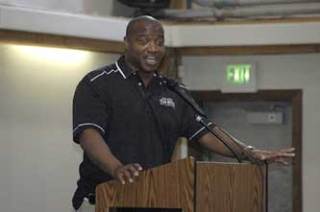MARYSVILLE – The sun shone down relentlessly, white hot, blinding and compounding the already warm 80-something degree weather in the late afternoon.
But the three fields of boys running touch football games were oblivious to the heat, reluctantly trading out their turn on the field and opting for a sideline view of the action instead of the cool of tents and water sitting about 20 yards away.
As the teams exchanged passes and tags, former Seattle Seahawk Mack Strong stands in one end zone watching the action, whistling tags and encouraging players with a good move.
Touch football games are just one aspect of a plan Strong and his wife Zoë conceived to reach out to the Pacific Northwest’s young native American population. In the group that has struggled to match the state’s on-time graduation percentile, Mack and Zoë – who is the executive director of Hope Worldwide for Washington state – saw a group in search of direction.
“It started mainly from the needs in native education,” said Zoë, whose Nez Perce tribe is one of several that benefited from the weekend activities on the Tulalip reservation. “It seemed like an ideal group that we could help and invest in.”
So, to complement their Team Works Academy program that tutors and mentors at-risk native youth in grades 4-8, the Strongs decided to reach out to middle school- and high school-aged youths with a three-day sports camp that extends the academy’s philosophy of “strong mind, strong body, strong character.” It fell this year July 10-12.
While clinics that taught football, basketball and volleyball skills were a large part of the weekend, camp broke down into leadership classes each afternoon. Coaches, many of them with college or professional experience in their sport, emphasized to campers the value of education to pursing their dreams and the importance of supporting one another.
As the camp wrapped up with an award ceremony, many campers got back on buses to take their newly acquired life skills home and put them to work – in the Muckleshoot, Lummi, Seattle and Tulalip communities.



